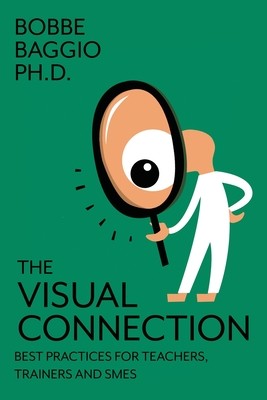
- We will send in 10–14 business days.
- Author: Bobbe Baggio
- Publisher: Advantage Learning Technologies, Inc.
- ISBN-10: 0991405153
- ISBN-13: 9780991405152
- Format: 15.2 x 22.9 x 1.1 cm, softcover
- Language: English
- SAVE -10% with code: EXTRA
Reviews
Description
The Visual Connection: You Listen With Your Eyes is about using visuals to help people learn. It offers simple tips that can be implemented for little or no money. "The Visual Connection" makes training materials, presentations, eLearning modules and PowerPoint screens better for learning. Using wonderful synchronous and asynchronous technologies that allow us to reach around the globe, more and more people are learning with visuals. With these tools we can reach far beyond the twenty of thirty people in a classroom or the three-hundred to one-thousand in an auditorium. Most people are not using even a fraction of the technological power available to them. Visuals help us to effectively use the technologies we have to help people learn. Visuals are a good and inexpensive place to start when using technologies because visual images have power. The brain responds both cognitively and emotionally to visual stimuli. Visuals have the power to attract and keep the learner focused on your intended content. Visuals can help learners absorb information by affecting their attention, perception, visualization, and imagination. Learning is a complex activity and can be affected by three very influential areas: prior knowledge, context and expectations. Visuals can act as stimuli for most of us because most of us are predominantly visual learners. We can create screens and supporting materials that really help people. Visual designers have known for a long time that if you don't use the CRAP principle (contrast, repetition, alignment and proximity), that is exactly what you will wind up with. We can create supportive learning environments that enhance, not detract, the probability that the learners will "get it". That is what teaching and learning is all about, isn't it? Whatever it is that we want them to learn, we want them to "get it". Visuals can help us do that.
- Author: Bobbe Baggio
- Publisher: Advantage Learning Technologies, Inc.
- ISBN-10: 0991405153
- ISBN-13: 9780991405152
- Format: 15.2 x 22.9 x 1.1 cm, softcover
- Language: English English
The Visual Connection: You Listen With Your Eyes is about using visuals to help people learn. It offers simple tips that can be implemented for little or no money. "The Visual Connection" makes training materials, presentations, eLearning modules and PowerPoint screens better for learning. Using wonderful synchronous and asynchronous technologies that allow us to reach around the globe, more and more people are learning with visuals. With these tools we can reach far beyond the twenty of thirty people in a classroom or the three-hundred to one-thousand in an auditorium. Most people are not using even a fraction of the technological power available to them. Visuals help us to effectively use the technologies we have to help people learn. Visuals are a good and inexpensive place to start when using technologies because visual images have power. The brain responds both cognitively and emotionally to visual stimuli. Visuals have the power to attract and keep the learner focused on your intended content. Visuals can help learners absorb information by affecting their attention, perception, visualization, and imagination. Learning is a complex activity and can be affected by three very influential areas: prior knowledge, context and expectations. Visuals can act as stimuli for most of us because most of us are predominantly visual learners. We can create screens and supporting materials that really help people. Visual designers have known for a long time that if you don't use the CRAP principle (contrast, repetition, alignment and proximity), that is exactly what you will wind up with. We can create supportive learning environments that enhance, not detract, the probability that the learners will "get it". That is what teaching and learning is all about, isn't it? Whatever it is that we want them to learn, we want them to "get it". Visuals can help us do that.


Reviews